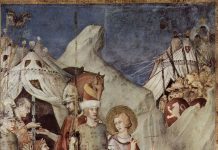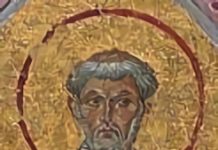Ecclesia semper reformanda est.
So goes the old saying – the Church, always in need of reform – applies now, perhaps, more than ever. And one of her greatest reformers was not a Pope, nor a bishop, nor a man, but a simple woman of great holiness, intelligence, character and strength, a Dominican tertiary, who lived ‘in the world’, but most definitely not ‘of the world’
Saint Catherine of Siena, like the Christ she loved and served so well, lived a brief life of 33 years, yet moved the world in the time she was given. Born in 1347, and who died on this day in 1380, and was in no uncertain terms a remarkable woman. She was the 22nd child (!) of Lapa, the daughter of a local poet, and Giacomo di Benincasa – a cloth dyer; Catherine, who developed into a healthy child, had a twin girl, Giovanna, who died soon after birth. The Benincasas ended up with 25 children (!) – this was a time, which went up unto modern times, when large families were seen as a ‘great blessing’. Alas, half of Catherine’s siblings died in infancy. So it was good that families were so large, for not only was infant mortality high, but the plague of the Black Death 1347-51 hit in the year that Catherine was born.
Catherine, whom her family called ‘euphrosyene‘, the ‘joyful one’, on account of her merry disposition. She showed signs of her vocation at an early age, eschewing the normal activities of young people, not least any interest in romance and marriage. At the tender age of seven, as recounted by her contemporary biographer, as well as her spiritual director, the Dominican priest Raymond of Capua (since beatified), she dedicated herself to Christ in a vision as his ‘bride’, and never looked back. Against all the allures of the world, she advised ‘build a castle within your mind, from which you can never flee‘. Immersed in contemplation, while acting in the world, Catherine received the stigmata (visible only to her, at her request to Christ), and for years, she seemed to subsist on the Eucharist alone, demonstrating quite vividly that he who eats the food that Christ will give, will never hunger.
Her inner locutions continued throughout her relatively brief life, culminating with her Dialogue of Divine Providence, a conversation between the saint and God, which Catherine dictated to her secretaries between 1377-78, a remarkable work, signifying the very thoughts of the Creator and Redeemer.
As a teenager, her parents insisted marry she marry her sister’s widower, but Catherine refused, praying and fasting, even cutting off her long hair. Her father relented, recognizing the will of God, and Catherine became a Dominican tertiary. Still technically a laywoman, she lived a life more rigorous than most religious, first in secluded prayer, then, at the command of Christ, in active good works. Spiritual, intelligent, charismatic, her followers were soon many, and she influenced the Church of the 14th century, going through travails that put our current troubles into context, and experienced more directly than most of the high-ranking churchmen of her age. Towards the end of her life, the ‘Great Western Schism’ began (1378 – 1417), with the Pope living in the scandalous court in Avignon in southern France under the dominant hand of King Philip the IV, ‘le Bel’. This was papal territory, but in practice, the Pope became a puppet of the king, which helped drive the Church into schism, with eventually to three rival claimants to the papacy.
Catherine was an early example of speaking truth to authority, sparing no pains nor ‘standing on ceremony’. Yet, unlike the future ‘Reformers’ of the sixteenth century, she stayed within the Church she loved (what would one do without the Mass and the Eucharist?).
Her letters urging the Holy Father, Gregory XI, that he must return the papacy to Rome, replete with dire threats she heard from God if he refused, might shock us with their boldness and forthrightness. Here is a brief excerpt from letter #74:
Up, father! Put into effect the resolution you have made concerning your return and the crusade. You can see that the unbelievers are challenging you to this by coming as close as they can to take what is yours. Up, to give your life for Christ! Isn’t our body the only thing we have? Why not give your life a thousand times, if necessary, for God’s honor and the salvation of his creatures? That is what he did, and you, his vicar, ought to be carrying on his work. It is to be expected that as long as you are his vicar you will follow your Lord’s ways and example.
Yet, Catherine showed that there is nothing wrong with ‘criticising’ the our pastors, Pope and bishops included, so long as it is done with and within reason, respectfully, with charity, good will and a healthy dose of prayer, as the current Code of Canon Law states, quoted the Catechism:
In accord with the knowledge, competence, and preeminence which they possess, [lay people] have the right and even at times a duty to manifest to the sacred pastors their opinion on matters which pertain to the good of the Church, and they have a right to make their opinion known to the other Christian faithful, with due regard to the integrity of faith and morals and reverence toward their pastors, and with consideration for the common good and the dignity of persons. (CCC, #907; CIC, 212, #3).
Something to ponder more deeply, as our own current crisis continues, and many elements of the Church again caving to secular ideologies.
As Catherine was to put it in her own vivid way:
Preach the Truth as if you had a million voices. It is silence that kills the world.
Moved by her urging, the Pope did return to the Eternal City, the centre of Christendom, in 1376, which at least commenced the process of regaining his authority, and healing the schism, completed at the Council of Constance in 1415.
Saint Catherine was one of the greatest of mystics in the history of the Church, and besides her Dialogue on Divine Providence, (from a woman who could neither read nor write), a masterpiece of spiritual and theological insight, her hundreds of letters and dozens of prayers are a model of beauty and intelligence, as well as masterpieces of early Tuscan. As she wrote in full humility, which is always grounded in truth:
I have tasted and seen the depth of your mystery and the beauty of your creation with the light of my understanding. I have clothed myself with your likeness and have seen what I shall be. Eternal Father, you have given me a share in your power and the wisdom that Christ claims as his own, and your Holy Spirit has given me the desire to love you. You are my Creator, eternal Trinity, and I am your creature. You have made of me a new creation in the blood of your Son, and I know that you are moved with love at the beauty of your creation, for you have enlightened me.
Catherine’s life, as are the lives of all God’s saints, is too full for a brief article, and I would highly recommend the classic and unsurpassed biography by Sigrid Undstet or Michael de la Bedoyere. Our Church could use more than a few more Catherines of Siena, steeped in prayer, chaste, pure, humble, obedient to Christ and His Church in the deepest sense.
Hailed as a saint upon her death, Catherine was canonized in 1461, and eventually declared a Doctor of the Church by Pope Saint Paul VI in 1970, along with Theresa of Avila, just after the Second Vatican Council, the first women to receive this honour, which only 37 saints hold. She is a powerful example and intercessor for all women, and men also, throughout the ages.
Saint Catherine of Siena, ora pro nobis!










